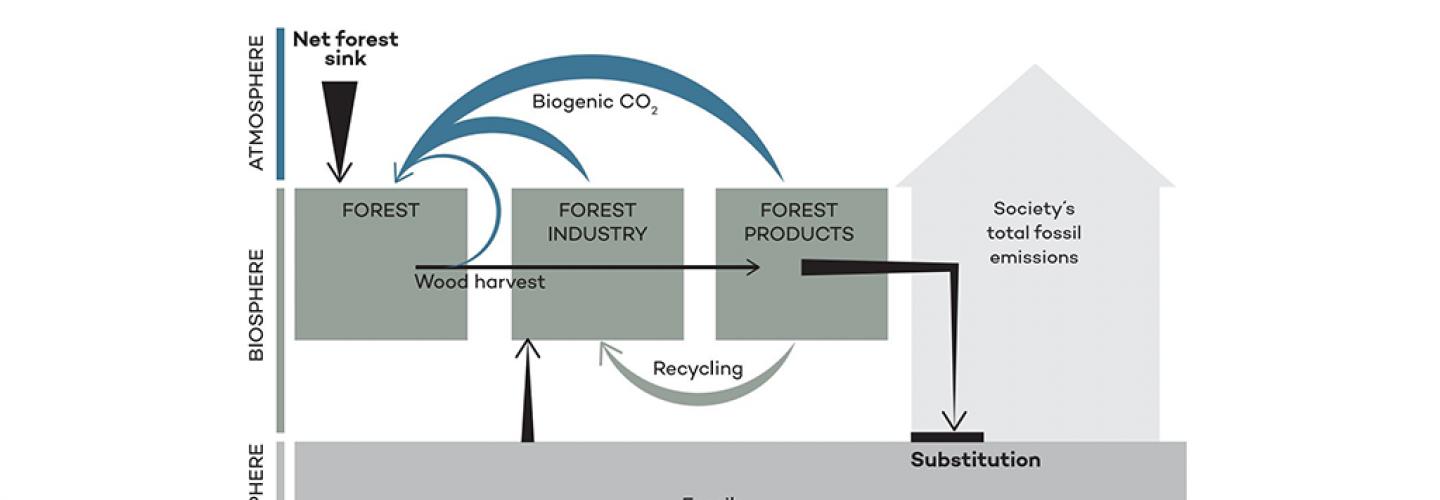
The Gordian knot
Current CO₂ markets and policies embrace carbon in forests, but do not recognise CO₂ benefits of substituting bioproducts for fossil based products with bioproducts. This undermines the role of the forest sector in climate change mitigation.
Growing forests removes large quantities of CO₂ from the atmosphere and stores it in trees and soil. When forests are managed sustainably, part of this carbon is stored, for a shorter or longer period, in various forest products. These products substitute fossil based products, they can be re-used and recycled, and at the very end of the cycle, they can be burned thus replacing fossil fuels. A recent study published by Cepi indicates that the positive climate impact of this sector in Europe amounts to around 800 million tonnes of CO₂ equivalents annually, which corresponds to 20% of all fossil emissions of the European Union. Half of this impact relates to increased CO₂ storage in forests, another half to the substitution of forest based materials and energy by fossil based products and biomass. The storage impact is well recognised, but the substitution impact is not included in carbon policies and markets. This is the Gordian knot that needs to be untied in order to capture all benefits of the forest sector in climate change mitigation.
It's bio, baby!
Forest products have a low carbon footprint, and they reduce demand for materials, products and energy that are fossil based. Concrete or plastic are examples of these materials. The existing climate reporting and policies do not take into consideration this kind of cross-sectoral impact. It is important to recognise that the forest based sector is a circular bioeconomy, which facilitates a simultaneous increase in carbon sinks and storage in forests, and a range of substitution benefits provided by forest based products and bioenergy.
The circular bioeconomy encompasses the production of renewable biological resources and waste streams into value added products, which can be recycled and maintained in the economy for several cycles with minimum waste. The circularity is based on sustainable forest management, which also provides large socio-economic benefits and facilitates biodiversity protection. Conserving forests for carbon storage would only terminate this circularity and substitution benefits, and result in increased fossil based emissions to meet the market demand.
A question of design
The policy imperfection is also embedded in carbon markets. Current market platforms take the CO₂ in forests into account, but they do not recognise the positive substitution impact of forest based products. While CO₂ stored in the forest has a value, the reduction in CO₂ emissions facilitated by forest based products and bioenergy does not have any value on these markets. This leads to massive-scale sub-optimisation in the long term from a climate perspective. CO₂ accumulation in forests is encouraged, resulting in lower forest growth and wood harvest over time. In the long term, when forests will become very old, this will lead to zero forest growth, harvest and substitution impact. Taking Europe as an example, this imperfection within the carbon market could, in theory, reduce the positive climate impact of the forest sector from 800 million tonnes of CO₂ equivalents to zero in the very long term.
How can this Gordian knot be untied? It is obvious that climate policies and carbon markets should embrace the positive impact of product substitution based on the circular bioeconomy. Forests should not be seen only as carbon storage, but also as a sustainable source of non-fossil, renewable and recyclable materials for a range of uses, and carbon benefits of forest based products should be recognised. This circular flow and related positive climate impact can be enhanced over time based on sustainable forest management and afforestation of land areas that do not have competing uses.
Put a tree on it
Alongside policy development, market based solutions can be created to encourage product substitution to reduce CO₂ emissions. In order to recognise substitution impacts, they need to be quantified. This calls for systems for tracking carbon along the supply and delivery chain of forest products from forests to end use markets. Such systems can be based on Blockchain or similar technologies, supported by participants of the value chain collaborating and sharing data on product flows. These technologies can be used to develop an open, distributable ledger to record the flow of carbon along the whole chain, from harvested wood to the processing and end use of a product. The participants, including industries, would greatly benefit from developing this technical solution, which would facilitate quantification of substitution benefits. The Gordian knot, that prevents the forest and forest based industry sector from taking its full role in climate change mitigation, needs to be untied. With well-designed policies and efficient carbon markets, the benefits of a circular bioeconomy can be maximised, and development towards a carbon neutral global economy accelerated.







